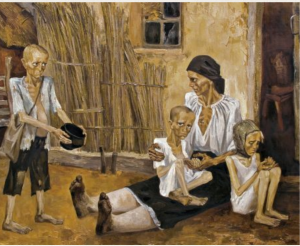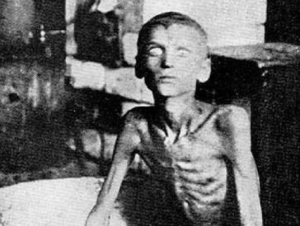 Walking down the streets in Ukraine’s once cosmopolitan cities and towns in the summer of 1933, it was not uncommon to see bodies laying, unadorned and flea-ridden, on the sidewalk or slumped against store walls, starved to death. At this point in the planned famine and genocide, Holodomor, people were starving in the Ukraine at the rate of 28,000 deaths a day.
Walking down the streets in Ukraine’s once cosmopolitan cities and towns in the summer of 1933, it was not uncommon to see bodies laying, unadorned and flea-ridden, on the sidewalk or slumped against store walls, starved to death. At this point in the planned famine and genocide, Holodomor, people were starving in the Ukraine at the rate of 28,000 deaths a day.
In the Ukrainian language, Holodomor means ‘Death Famine.’ Now, it is commonly used to refer to a two-year period where Josef Stalin and the Soviet Union committed a planned famine and genocide against the Ukrainian people from 1932-1933. The famine resulted in anywhere from seven to twelve million deaths, the majority of which were the gruesome deaths of infants born to malnourished mothers. It is hard to overstate the devastating nature of these two years, as a once-proud nation was reduced to a ghost of its former self. It touched every part of society, and the deaths were long, drawn-out. They usually happened on the street, living corpses taking their final breaths, their ribs protruding from their chests. There is evidence of widespread cannibalism:
“Survival was a moral as well as a physical struggle. A woman doctor wrote to a friend in June 1933 that she had not yet become a cannibal, but was “not sure that I shall not be one by the time my letter reaches you.” The good people died first. Those who refused to steal or to prostitute themselves died. Those who gave food to others died. Those who refused to eat corpses died. Those who refused to kill their fellow man died. Parents who resisted cannibalism died before their children did.” (Snyder)
The genocide was inherently political and had two broad motivations. The first was an attempt by Stalin to weaken Ukraine’s strength and stop any sort of Ukrainian independence movement. As the wealthiest region of the Soviet Union, of which the fertile soils were largely the key to its agricultural plans, Ukraine was perhaps the Soviet Union’s weakest link. It was also the Soviet Union’s bridge to Europe, with a culture much different than any other major region in the Soviet Union. Because of this, it had been given special allowances of autonomy under Lenin in the 1920s, something Stalin saw as a major threat to the Soviet Union. (Source)
The second motivation had to do with Ukraine’s agricultural importance. Known as the ‘breadbasket’ of the Soviet Union, Ukraine was an essential part of Stalin’s plan for industrialization and agricultural dominance, specifically the policy of collectivization. Many scholars blame the immense strain these policies put on the agricultural output of Ukraine as a cause for the violent requisition of any agricultural output in Ukraine, and the harsh punishments if any Ukrainian farmer refused to give up his entire yield to the state.
Unlike the Holocaust, a genocide of similar scope, the Holodomor genocide was virtually unknown outside of Ukraine, and still is widely unknown around the world. One of the only foreigners brave enough to go into the Ukraine and report on the genocide was Gareth Jones, a British diplomat, and journalist who described the horrors he witnessed.

“If any man woman or child goes out into the fields at night, in the summer, and picks a single ear of wheat, than the punishment according to law, is death by shooting, the communist’s explained to me.”
Jones also exposed the rule dubbed “The Law of the Five Ears of Wheat,” a crucial piece of evidence is understanding the Politburo’s involvement in the famine. Signed by Mikhail Kalinin, head of the USSR central executive committee, it stated “Use judicial repressions of the highest degree as measures of social protection against theft of collective farm property: execution by shooting and confiscation of all property.” (Holodomor)
The end of the genocide was not some grand liberation or successful revolt. No, it was simply successful. Stalin paralyzed the future of the Ukrainian people, asserted his dominance over the region, and managed to effectively hide one of the largest genocides in history from the world. The best thing we can do, almost a century later, is to make sure that more and more people realize the evils of the Soviet Union and heed their lessons.
